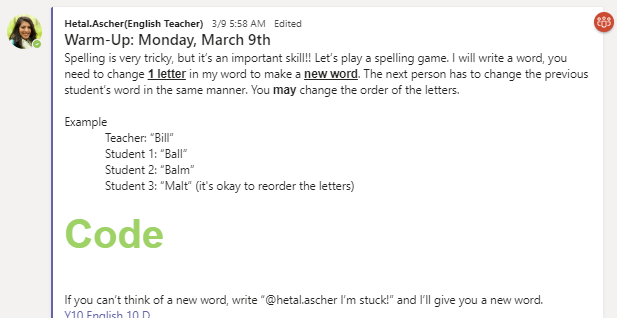Quick Tip: 3 Tips for If You Suddenly Find Yourself Teaching Online
by Hetal Ascher
I teach ESL
in an international school in a midsized city in China, called Suzhou. In
mid-January, I received the news that all of my lessons were to be online
because school was cancelled. Now, as I have completed several weeks of
teaching my high school students online, I have had the opportunity to pause
and reflect on my experience. My most significant lesson has been about
leveraging foundational classroom skills to maximize engagement and realizing
that the technology is just a platform.
Tip 1: Build
Community
For many
learners, social media and online communication have always been a part of
daily life. In an online classroom, we can tap into some of these preexisting
schema and utilize them for building classroom community. Even something as
simple as encouraging students to “like” a post or creating a venue for casual
chatting adds a little life back into your classroom.
Adding in
games or opportunities for humor also builds community. For a daily warm-up, I
asked students to find a photo of an animal and write two sentences from the
animal’s perspective. Here is an example response:

Haha! Do you know why you
can't see me?
Because I am sitting on your head! – Joseph
Nie
I have also
utilized a plethora of ESL games online (see the example in Figure 1). You can
find some great no-prep games at eslgames.com;
there are also a lot of excellent activities in New
Ways in Teaching With Games and New
Ways in Teaching With Creative Writing, both from TESOL
Press and available digitally. In some ways, it is even easier to play online
because students have plenty of think time and are able to choose when they
respond.

Figure 1. Online teaching warm-up game
example.
(Click image to enlarge.)
Tip 2: Structure Your
Video Conferences
Video
meetings are harder than they seem. In video meetings, we lack so many of the
classroom management tools normally available to us, like proximity and eye
contact. These tools are what give most of us that sense of having our finger
on the pulse of what is happening in our classroom.
After
suffering through my first few video meetings, I learned that small groups are
the way to go. Meeting with 10 students for 10 minutes is more effective for
group discussion than 30 students in 30 minutes. Structure and preparation are
also vital. Tell your students ahead of time what the icebreaker and discussion
questions are and how much they will be expected to speak. Then follow an order
of speaking. For example, “Yang Lin will start now, and Tony will be next.”
Over time, students will open up and become more active.
Tip 3: Keep
Collaborating
When school
is online, it’s easy to turn off the collaboration between teachers. For many
of us who take pride in a job well done, this change to online teaching has
created a lack of confidence—don’t let these negative feelings cause you to
shut your colleagues out. Ask a trusted colleague to be best practice buddies
and invite each other to be members of your virtual classrooms where you can
observe each other and trade tips. You can also get involved with the greater
community of ESL teachers via TESOL
interest sections, where you’ll find others to collaborate with. As
mandatory online teaching threatens to push us apart, let’s fight back by
growing closer as a community of ESL professionals serving the world’s learners.
Hetal
Ascher is currently the head of English as
an Additional Language at Dulwich International High School, Suzhou. Before
that, she worked with English learners at a public middle school in Minnesota.
She obtained her MA in ESL education from Hamline University and a BA in ESL
education K–12 from University of Northwestern, St. Paul.
TESOL Blogs
Interested in writing a blog for TESOL?
Read the submission guidelines and send us your post!
Check out some of the most recent TESOL Blogs:
|
Coronavirus Resources for ELT, by Tomiko Breland

As the new coronavirus (COVID-19) evolves and spreads globally, closing down public venues, shuttering people in their homes, and suspending schooling, many teachers are left unsure what to do. English language learners and their families can find themselves in a particularly stressful place if they don’t have the language proficiency to fully understand the facts about the virus and discern truth from misinformation. Additionally, because the epicenter of the outbreak is located in China, some people identifying as Asian and Asian American have been the subject of racially charged bullying and aggression.
All of this means that it’s crucial to provide our students—English learners and proficient English speakers alike—and their families with accurate and updated information that they can comprehend, whether you’re still teaching face to face or all your classes have moved online. Here are some resources for teaching and learning to help you through this challenging time. Read more. |
|
Taking Your Teaching Online, by Stephanie Marcotte

With the physical and social distancing surrounding COVID-19, educators are tasked with moving their physical classes into an online space. This is an exciting adventure; however, it can be equally as stressful. This is especially true under the conditions surrounding COVID-19.
To provide some scaffolding throughout this transition, this blog provides information about choosing between synchronous and asynchronous online learning, selecting a learning management system, selecting resources for virtual call-in classes, utilizing free resources, and possible online activities to integrate into your online class. These are fundamental areas to think about as you transition into online teaching. Read more. |
|
Serious Games for the Classroom, by Jeff Kuhn
 Greetings and welcome to another edition of the TESOL games and learning blog! Greetings and welcome to another edition of the TESOL games and learning blog!
When searching for video games to incorporate into the classroom, choices often fall into two broad categories: educational games and commercial off-the-shelf (CotS) games.
Serious games is a lesser known category that overlaps with both educational and CotS games. Serious games are digital or analogue games designed to educate, train, or inform players on a particular topic. The term gained traction is the early 2000s and solidified as a movement to use the interactive nature of games to engage students in challenging topics or foster empathy in students through interactive storytelling. Read more. |